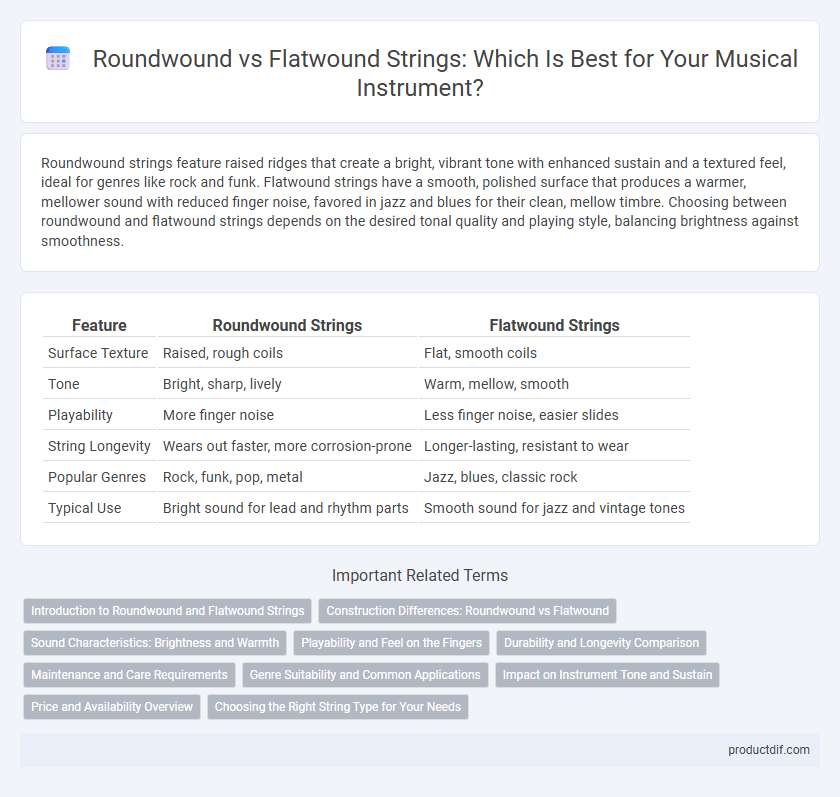Roundwound strings feature raised ridges that create a bright, vibrant tone with enhanced sustain and a textured feel, ideal for genres like rock and funk. Flatwound strings have a smooth, polished surface that produces a warmer, mellower sound with reduced finger noise, favored in jazz and blues for their clean, mellow timbre. Choosing between roundwound and flatwound strings depends on the desired tonal quality and playing style, balancing brightness against smoothness.
Table of Comparison
| Feature | Roundwound Strings | Flatwound Strings |
|---|---|---|
| Surface Texture | Raised, rough coils | Flat, smooth coils |
| Tone | Bright, sharp, lively | Warm, mellow, smooth |
| Playability | More finger noise | Less finger noise, easier slides |
| String Longevity | Wears out faster, more corrosion-prone | Longer-lasting, resistant to wear |
| Popular Genres | Rock, funk, pop, metal | Jazz, blues, classic rock |
| Typical Use | Bright sound for lead and rhythm parts | Smooth sound for jazz and vintage tones |
Introduction to Roundwound and Flatwound Strings
Roundwound strings feature raised windings that create a textured surface, producing bright, crisp tones favored in rock and jazz genres. Flatwound strings have smooth, flat windings that offer a mellow, warm sound with less finger noise, often preferred in blues and vintage-style playing. Choosing between roundwound and flatwound strings depends on desired tonal quality and playing style.
Construction Differences: Roundwound vs Flatwound
Roundwound strings feature a round wire wrapped tightly around a core, creating a textured surface that enhances brightness and sustain. Flatwound strings use a flat wire wrapped smoothly around the core, resulting in a slicker feel and a warmer, mellower tone. The construction differences directly impact playability, tone, and string lifespan, with roundwounds offering more harmonic richness and flatwounds providing reduced finger noise and smoother glide.
Sound Characteristics: Brightness and Warmth
Roundwound strings produce a bright, vibrant tone with enhanced sustain and harmonic complexity, making them ideal for genres requiring articulation and clarity. Flatwound strings deliver a warmer, smoother sound with reduced finger noise and less high-end brightness, favored in jazz and vintage music styles. The choice between roundwound and flatwound strings significantly impacts the tonal brightness and warmth, shaping the overall sound character of the instrument.
Playability and Feel on the Fingers
Roundwound strings provide a textured surface that enhances finger grip and produce a bright, vibrant tone favored in rock and pop genres. Flatwound strings offer a smooth, polished feel, reducing finger noise and delivering a mellow, warm sound preferred in jazz and blues. Players seeking ease on the fingers and quieter playing often opt for flatwounds, while those prioritizing attack and articulation tend to choose roundwounds.
Durability and Longevity Comparison
Roundwound strings provide brighter tone but tend to wear out faster due to their raised winding edges, making them less durable over extended playing sessions. Flatwound strings offer superior longevity and durability as their smooth surface resists dirt and corrosion while reducing finger noise. Musicians seeking long-lasting strings often prefer flatwounds for their consistent performance and extended lifespan.
Maintenance and Care Requirements
Roundwound strings require more frequent cleaning to remove dirt and oils that accumulate on their ridged surface, which can cause corrosion and reduce lifespan. Flatwound strings, with their smooth surface, resist dirt buildup and last longer, making them easier to maintain and requiring less frequent replacement. Proper wiping after playing and using string cleaners specifically designed for each type can significantly prolong the string's tone and durability.
Genre Suitability and Common Applications
Roundwound strings are favored in genres like rock, metal, and funk due to their bright tone and enhanced sustain, making them ideal for aggressive playing styles and intricate fingerwork. Flatwound strings suit jazz, blues, and vintage styles by delivering a smooth, mellow sound with reduced finger noise, preferred for clean, warm bass lines and rhythm playing. Bassists often choose roundwound for slap and pop techniques, while flatwound strings excel in fingerstyle and upright bass applications.
Impact on Instrument Tone and Sustain
Roundwound strings produce a bright, vibrant tone with enhanced sustain, making them ideal for rock and metal genres where clarity and punch are essential. Flatwound strings deliver a warmer, smoother sound with reduced brightness and sustain, favored in jazz and blues for their mellow tonal quality and muted finger noise. The choice between roundwound and flatwound strings significantly influences the instrument's overall tonal character and sustain duration, impacting playing style and musical genre suitability.
Price and Availability Overview
Roundwound strings generally offer a more affordable price point and wider availability across music stores and online platforms compared to flatwound strings. Flatwound strings tend to be pricier due to their manufacturing process and are often found in specialty shops catering to jazz and vintage instrument players. Musicians seeking budget-friendly options or quick replacement strings usually opt for roundwound varieties, while those prioritizing tone may invest more in flatwound strings despite their limited retail presence.
Choosing the Right String Type for Your Needs
Roundwound strings produce bright, vibrant tones ideal for genres like rock and jazz, offering enhanced sustain and articulation. Flatwound strings deliver a smoother, mellower sound with reduced finger noise, preferred for jazz, blues, and vintage tones. Selecting between roundwound and flatwound depends on your desired sound profile, playing style, and comfort preferences.
Roundwound strings vs Flatwound strings Infographic

 productdif.com
productdif.com